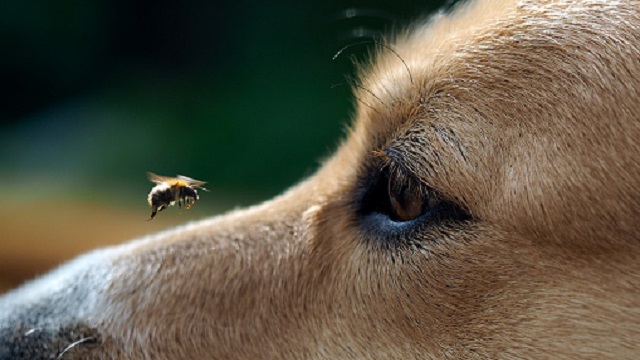Help – Dog Stung By A Bee! First Aid For Bee Stings In Dogs
Let’s find out everything you need to know about bee stings in dogs, including the correct action to take if your dog is stung by a bee.
- Bee stings can harm dogs, causing mild to severe reactions depending on individual allergies.
- If stung, remove the stinger carefully, avoiding pressure on the venom sac.
- Clean the sting site and apply a bicarbonate paste to neutralize venom.
- Monitor for allergic reactions, including difficulty breathing and swelling; seek vet help if needed.
- Administer pain medication only after consulting your veterinarian to prevent harm.
Are Bee Stings Harmful To Dogs?

Bee stings can be harmful to dogs, especially if they have an allergic reaction to the sting. Most dogs will experience mild to moderate swelling, pain, and redness at the site of the sting, which can be uncomfortable but generally not life-threatening. However, some dogs can have a severe allergic reaction known as anaphylaxis, which can be fatal if left untreated.
In addition, if a dog is stung multiple times or if they accidentally ingest a bee, they may experience more severe symptoms. Stings to the mouth and nose are of particular concern, as swelling can obstruct the airway and cause breathing difficulties. Dogs with pre-existing medical conditions or compromised immune systems may also be more susceptible to the harmful effects of bee stings.
Overall, while bee stings may not be harmful to all dogs, it’s important to monitor your dog closely after a sting and seek veterinary attention if you notice any concerning symptoms that may indicate an allergic reaction.
What To Do If Your Dog Is Stung By A Bee

If your dog is stung by a bee, it’s important to take immediate action to minimize the pain and reduce the risk of a serious reaction.
- 1 – If you can see the stinger, carefully attempt to remove it.
Gently scrape the area with a solid object such as a credit card to remove the stinger. Be careful not to squeeze the venom sac at the base of the stinger! This can release more venom into your dog’s body. Tweezers are not recommended for this reason.
- 2 – Clean and soothe the affected area.
To help prevent infection, clean the area around the sting with a mild pet-safe skin disinfectant or saline solution. Follow this with a thick paste of bicarbonate of soda and water which will help to neutralize any residual venom.
- 3 – Apply a cold compress.
Applying a bag of ice or a cold pack to the affected area will help to reduce swelling and pain. Wrap the compress in a towel before applying it to your dog’s skin to prevent frostbite.
- 4 – Monitor your dog.
Watch your dog closely for signs of an allergic reaction, such as difficulty breathing, swelling of the face or throat, vomiting, diarrhea, or collapse. If you spot any of these symptoms, seek veterinary advice immediately.
- 5 – Administer medication if necessary.
If your dog is in pain, you can give pain medication but make sure to consult with your vet first to determine the proper type and dosage. Never give any pain medication, especially those intended for humans, to a dog without consulting a veterinarian first.
What To Do If Your Dog Has An Allergic Reaction To A Bee Sting

Allergic reactions to bee stings in dogs cause rapid onset of symptoms. You may notice some of the following symptoms within 30-60 minutes.
Signs of anaphylaxis include difficulty breathing, swelling of the face or throat, vomiting, diarrhea, collapse, and even seizures. If you suspect your dog is having an allergic reaction to a bee sting, seek veterinary attention immediately.
Your dog will likely need to attend the nearest veterinary clinic immediately. However, your veterinarian may also be able to recommend some first aid treatment to administer at home first. This may include using antihistamines to reduce the allergic response.
Maven Pet focuses on improving the quality of life of our pets with technology, using artificial intelligence (AI) to enable proactive pet care. By accurately collecting and monitoring pet data 24/7 and flagging any irregularities, Maven Pet empowers pet parents and veterinarians to stay ahead of potential health issues, ensuring the well-being and longevity of our beloved companions.




